[1]
А.P. Grudev, L.F. Mashkin, М.I. Hanin, Rolling production technology, Metallurgy, 1994, 656 p.
Google Scholar
[2]
М.А. Benyakovsky, Surface quality of automobile sheet, Metallurgy, 1969, 152 p.
Google Scholar
[3]
М.А. Benyakovsky, Е.P. Sergeev, Surface defects of automobile sheet, Metallurgy, 1979, 72 p.
Google Scholar
[4]
А.А. Bogatov, О.I. Mizhiritsky, S.V. Smirnov, Plasticity resource of metals during pressure treatment, Metallurgy, 1984, 144 p.
Google Scholar
[5]
R. Frobin, Umformvermogen metallischer Werkstoffe in Abhangigkeit von der Art des Spannungszustands, Neue Hutte, 1986, 6, pp.201-205.
Google Scholar
[6]
V.N. Skorohodov, G.Y. Barmin, P.P. Chernov, Rolling out of surface defects in cold rolling metal and strip quality, Steel, 1991, 5, pp.45-48.
Google Scholar
[7]
А.B. Naizabekov, V.А. Talmazan, I.Y. Evtushenko, K.V. Manturov, А.S. Erzhanov, Statistical evaluation of the quality of cold-rolled sheet, Proceedings of V International scientific and practical conference «Scientific and technological progress in the metallurgy», KSIU, 2009, pp.353-361.
Google Scholar
[8]
E.А. Garber, R.N. Ganichev, I.А. Kozhevnikova, Improving of speed limits setting of continuous cold rolling mills, Proizvodstvo Prokata, 2005, 4, pp.6-13.
Google Scholar
[9]
E.А. Garber, E.N. Shebanits, Е.V. Diligensky, О.А. Pobegailo, N.P. Medvedev, Optimization of the structure of the deformation zone on the mill 1700, Steel, 2007, 1, 48-50.
Google Scholar
[10]
Y.N. Kuznetsov, V.I. Kuzubov, А.B. Voloschenko, Mathematical programming, High school, 1980, 300 p.
Google Scholar
[11]
I.L. Akulich, Mathematical programming in examples and problems, High school, 1986, 319 p.
Google Scholar
[12]
S. Roberts, Dynamic programming in the processes of chemical technology and management methods, Mir, 1965, 488 p.
Google Scholar
[13]
S.S. Kolpakov, S.B. Kuznetsov, V.K. Potemkin, Problems of development of the integrated management information system by sheet production, Intermet engineering, 1997, 272 p.
Google Scholar
[14]
А.L. Ostapenko, E.E. Beygelzimer, N.V. Minenko, E.N. Shebanits, А.V. Kuzmin, Software of designing of rolling technology of sheets and strips, Steel, 2006, 8, pp.56-59.
Google Scholar
[15]
Y.N. Loginov, Adhesion of metal on the rolls during sheet rolling, Proizvodstvo Prokata, 2006, 10, pp.9-12.
Google Scholar
[16]
Y.N. Loginov, Y.V. Inatovich, The mechanism of formation of defects on the strip during rolling from adhesion on the roll, Proizvodstvo Prokata, 2008, 8, pp.5-7.
Google Scholar


